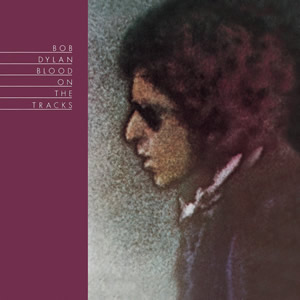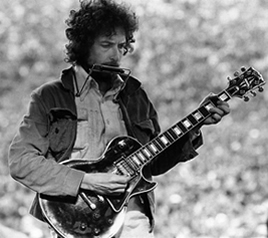Blood On the Tracks
by Bob Dylan
 Blood On the Tracks contains all the elements of Bob Dylan‘s classic, 1960s outputs, with the staples of the acoustic guitar, the harmonica, and the poetic lyrics delivered in expert fashion. It also fit in well with those earliest works as Dylan’s return to Columbia Records after a short stint with Asylum in the early 1970s. However, this fifteenth studio album by the artist is thematically unlike anything he had done before, as a raw and confessional work apparently influenced by the breakup of his marriage (a claim that Dylan has both denied and confirmed in subsequent years). Initially receiving lukewarm reviews, the album has collected ever-growing acclaimed in the four decades since its release, with many claiming it may be his finest overall release, if not his best produced.
Blood On the Tracks contains all the elements of Bob Dylan‘s classic, 1960s outputs, with the staples of the acoustic guitar, the harmonica, and the poetic lyrics delivered in expert fashion. It also fit in well with those earliest works as Dylan’s return to Columbia Records after a short stint with Asylum in the early 1970s. However, this fifteenth studio album by the artist is thematically unlike anything he had done before, as a raw and confessional work apparently influenced by the breakup of his marriage (a claim that Dylan has both denied and confirmed in subsequent years). Initially receiving lukewarm reviews, the album has collected ever-growing acclaimed in the four decades since its release, with many claiming it may be his finest overall release, if not his best produced.
After stellar success and acclaim through much of the 1960s, Dylan stumbled a bit as he entered the 1970s with the release of several uneven albums. 1970s Self Portrait was a double LP containing mainly cover tunes, while his acting role and soundtrack for the 1972 film Pat Garrett and Billy the Kid was largely forgettable save for the classic track, “Knockin’ On Heaven’s Door”. Backed by The Band, Dylan released Planet Waves in 1973, which spawned two versions of the standard “Forever Young”. Dylan and The Band then embarked in his first tour since early 1967, with 40 dates in North America in early 1974, which in turn spawned the live double album Before the Flood.
With his return to Columbia came an affair with a woman in that organization and the subsequent deterioration of Dylan’s marriage to Sara, his wife of ten years and mother of his four children. Beyond this situation, other influences on the material of Blood On the Tracks were the short stories of Russian author Anton Chekov along with Dylan’s art lessons with painter Norman Raeben. Produced by Dylan, the tracks for the album were originally recorded in New York in September 1974 with the album set for a December release. However, at the urging of his brother David Zimmerman, five tracks were re-recorded in Minneapolis in order to relieve some of the “starker sounding” numbers, delaying the album’s release until early 1975. Only one of the original versions of these five songs have been officially released by Dylan.
 Blood On the Tracks by Bob Dylan |
|
|---|---|
| Released: January 20, 1975 (Columbia) Produced by: Bob Dylan Recorded: A & R Recording, New York, & Sound 80 in Minneapolis, MN, September-December, 1974 |
|
| Side One | Side Two |
| Tangled Up In Blue Simple Twist of Fate You’re a Big Girl Now Idiot Wind You’re Gonna Make Me Lonesome When You Go |
Meet Me In the Morning Lily, Rosemary and the Jack of Hearts If You See Her, Say Hello Shelter from the Storm Buckets of Rain |
| Primary Musicians | |
| Bob Dylan – Lead Vocals, Guitars, Harmonica Barry Kornfeld – Guitars Paul Griffin – Keyboards Tony Brown – Bass Bill Berg – Drums |
|
The album begins with “Tangled Up In Blue”, one of the re-recorded tracks from Minneapolis which on the surface is a bright account of the sad recollection of a lost love. That being said, the poetic lyrics seem to be much more complex than those of a linear story and are delivered in a pleasant and melodic manner within a repeating pattern of acoustic music with slight bass and drums. Released as a single, the song reached the Top 40 on the pop charts in 1975 and has since been regarded as one of Dylan’s finest compositions. “Simple Twist of Fate” is built in much the same way as the opener but with a more melancholy tone, through its descending riff and sparse arrangement with only Dylan’s acoustic and the bass of Tony Brown musically. The song is at once sorrowful, regretful, and peaceful with an overall vibe which reaches into your soul and seems to make personal sense no matter what the original intent of the lyrics.
“People tell me it’s a sin to know and feel too much within, I still believe she was my twin but I lost the ring, she was born in spring but I was born too late, blame it on a simple twist of fate…”
The next two songs on the album are Minneapolis re-recordings. “You’re a Big Girl Now” differs in arrangement and approach than the first two songs, being much more adult contemporary and featuring Thomas McFaul on piano and multiple guitarists accompanying Dylan. While all the songs on Blood On the Tracks have a bit of negative aura, “Idiot Wind” is much more biting and cynical than the other, more poetic songs. Still, this is an excellent listen as it is vocally melodic and dramatic and features a heavy presence of Hammond organ throughout by Paul Griffin. The first side concludes with a short, bright, happy-go-lucky tune called “You’re Gonna Make Me Lonesome When You Go”, which includes much of the same sound and elements of Dylan’s sixties outputs. A strongly strummed acoustic and bouncy bass presented in a bluegrass mode with a Dylanesque edge, the hopeless lyrics are delivered with the most upbeat smile possible.
 The second side begins with “Meet Me in the Morning”, a decidedly bluesy acoustic track, with steady rhythms set in a way which could’ve fit well as a Rolling Stones song. Here, the rather standard lyrics take a back seat to the music and atmosphere, which is very cool and entertaining, especially during the ending, wild, guitar lead. “Lily, Rosemary and the Jack of Hearts” is a nearly nine minute story-telling song set to an upbeat, Country rhythm. This complex story with multiple characters is unfortunately delivered in a mundane fashion due to its endless repetition and Dylan would later perfect this type of saga with the much better “Tweeter and the Monkey Man” on the Traveling Wilburys debut album a decade and a half later. “If You See Her, Say Hello”, returns to the slow and sad approach with more exquisite production of the dual acoustic and consistent percussion before the song dissolves with a fine, simple instrumental.
The second side begins with “Meet Me in the Morning”, a decidedly bluesy acoustic track, with steady rhythms set in a way which could’ve fit well as a Rolling Stones song. Here, the rather standard lyrics take a back seat to the music and atmosphere, which is very cool and entertaining, especially during the ending, wild, guitar lead. “Lily, Rosemary and the Jack of Hearts” is a nearly nine minute story-telling song set to an upbeat, Country rhythm. This complex story with multiple characters is unfortunately delivered in a mundane fashion due to its endless repetition and Dylan would later perfect this type of saga with the much better “Tweeter and the Monkey Man” on the Traveling Wilburys debut album a decade and a half later. “If You See Her, Say Hello”, returns to the slow and sad approach with more exquisite production of the dual acoustic and consistent percussion before the song dissolves with a fine, simple instrumental.
Wrapping up the album are two more top notch tunes. “Shelter from the Storm” features much the same arrangement as “Simple Twist of Fate” on the first side with the theme switching to that of asylum. Dylan’s fine vocals and melody carries this three chord song with strong lyrical imagery. “Buckets of Rain” is the perfect closer for this album, simple but effective with vocals reminiscent of the Nashville Skyline era. The song seems to offer closure to the all the heartbreak left in the wake of this collection of songs.
Blood On the Tracks topped the charts in the US and reached the Top 5 in the UK, while achieving double-platinum status, making it one of Dylan’s best selling albums in his vast collection. While there was much success, Dylan quickly pivoted away from the confessional style with the more political-inspired follow-up, Desire in 1976 followed by Dylan’s foray into Gospel music later in the decade.
~
Part of Classic Rock Review’s celebration of 1975 albums.





February 12, 2019 @ 6:25 pm
Buckets of rain is by far my favorite track on this album. The agony he feels pours out of his guitar and into your soul like a well aged sour mash bourbon, slightly bitter and rough at first, then it finishes with a warm emptiness.